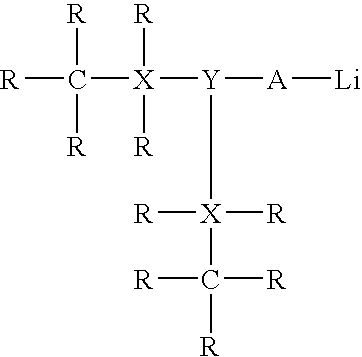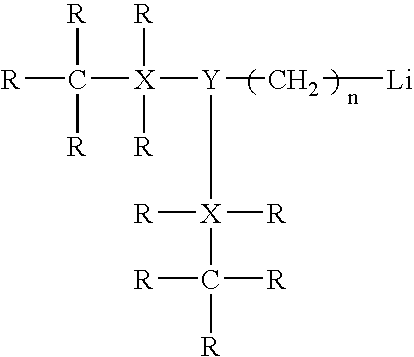Amine containing catalyst system and methods of use thereof
- Summary
- Abstract
- Description
- Claims
- Application Information
AI Technical Summary
Benefits of technology
Problems solved by technology
Method used
Image
Examples
example 1
[0088]In this experiment, 1063 g silica / alumna / molecular sieve-dried premix containing 18.8 weight percent 1,3 butadiene was charged into a one-gallon reactor. 1.22 mL of 0.47M solution of barium salt of di(ethylene glycol) ethylether (BaDEGEE) in ethylbenzene, 2.29 mL of a 1.0M solution of tri-n-octylaluminum (TOA) in hexanes, 1.71 mL of 0.99M solution of n-butyllithium (n-BuLi) in hexanes, and 0.57 mL of 1.0M of piperazine in hexanes were added to the reactor. The molar ratio of BaDEGEE to TOA to n-BuLi and to Piperazine was 1:4:3:1.
[0089]The polymerization was carried out at 90° C. The GC analysis of the residual monomer contained in the polymerization mixture indicated that the monomer conversions at 80 minutes and 100 minutes were 89.5% and 92.4%, respectively. 3 ml of 1.0M ethanol was added to shortstop the polymerization. The polymer cement was then removed from the reactor and stabilized with 1 phm antioxidant. After evaporating hexanes, the resulting polymer was dried in a ...
example 2
[0091]The procedure described in Example 1 was utilized in this example except that 3.43 mL of 1.0 M solution of piperazine in hexanes was added. Therefore, making the molar ratio (BaDEGEE / TOA / n-BuLi / piperazine) 1:4:3:6. The GC analysis of the residual monomer contained in the polymerization mixture indicated that the monomer conversions at 4 hours and 7 hours were 91.0% and 94.7%, respectively. The resulting polybutadiene polymer was determined to have a Tg at −90° C. and a Tm at +38.0° C. The Mooney viscosity (ML-4) at 10° C. was 89. The Mn and the Mw of the resulting polymer were 400,100 g / mol and 610,300 g / mol, resulting in a polydispersity of 2.23. Carbon-13 NMR analysis showed a trans 1,4 polybutadiene content of 84.7%, cis 1,4 polybutadiene content of 11.10%, and a 1,2 polybutadiene content of 4.2%.
example 3
[0092]In this experiment, 986 g of a silica / alumna / molecular sieve-dried premix containing 20.27 weight percent 1,3 butadiene and 900 g of hexane were charged into a one-gallon reactor. 2.0 mL of 0.5M solution of barium salt of di(ethylene glycol) ethylether (BaDEGEE) in ethylbenzene; 4 mL of a 1.0M solution of tri-n-octylaluminum (TOA) in hexanes; 3 mL of 0.99M solution of n-butyllithium (n-BuLi) in hexanes; and 1.0 mL of 1.0M of N-methyl piperazine in hexanes were added to the reactor. The molar ratio of BaDEGEE to TOA to n-BuLi and to N-methyl piperazine was 1:4:3:1.
[0093]The polymerization was carried out at 90° C. The GC analysis of the residual monomer contained in the polymerization mixture indicated that the monomer conversions at 150 and 300 minutes were 99.1% and 99.9%, respectively. 3 mL of 1.0M ethanol was added to shortstop the polymerization. The polymer cement was then removed from the reactor and stabilized with 1 phm of antioxidant. After evaporating hexanes, the re...
PUM
| Property | Measurement | Unit |
|---|---|---|
| Temperature | aaaaa | aaaaa |
| Temperature | aaaaa | aaaaa |
| Percent by mass | aaaaa | aaaaa |
Abstract
Description
Claims
Application Information
 Login to View More
Login to View More - R&D
- Intellectual Property
- Life Sciences
- Materials
- Tech Scout
- Unparalleled Data Quality
- Higher Quality Content
- 60% Fewer Hallucinations
Browse by: Latest US Patents, China's latest patents, Technical Efficacy Thesaurus, Application Domain, Technology Topic, Popular Technical Reports.
© 2025 PatSnap. All rights reserved.Legal|Privacy policy|Modern Slavery Act Transparency Statement|Sitemap|About US| Contact US: help@patsnap.com



